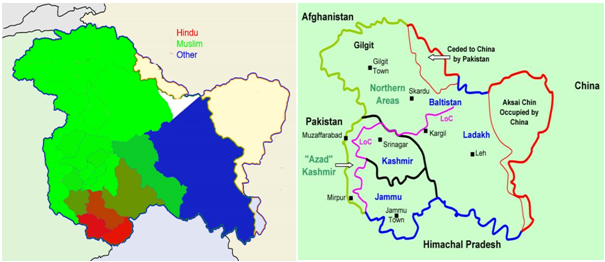What is the issue?
- Various incidents in Kashmir valley have spotted some long-term dynamics and regional differences in J&K.
What is the account of diversified ethnic groups in J&K?
- Kashmiri speakers - Muslims and Hindu/Pundits; these people view themselves more cultured and articulate voice of the state (valley based).
- Non-Kashmiri speakers - These groups are from the erstwhile State of J&K.
- They claim themselves the ‘Kashmiri’ in India, Pakistan, or in the diaspora (non-valley based).
- Gujjars groups -Bakherwals are the third-largest ethnic group in the State.
- They have always lived on the margins of society because of their nomadic lifestyle.
- These people, ethnically, culturally, and linguistically would otherwise identify more with the Jammu region.
- Ladakhis - These people are indigenous ethnic groups of the Leh-Ladakh region.
- They live in the most remote parts of the state.
What are the prevailing regional differences in J&K?
- Valley-based Kashmiris feel it hard to acknowledge the presence and aspirations of other ethnic and identity groups in the State.
- Most of the Bakherwals fear their marginalisation in an autonomous political set-up.
- They are keen on getting some institutional assurance of their recognition as groups separate from the Valley Kashmiris.
- Hindu communal sentiment operating within the broader right-wing nationalist framework has also been visible to bring the State under one flag and one Constitution.
- The sense of deprivation and discrimination at the hands of the Valley and the communal sentiment have fed into each other.
- With no institutional mechanisms to redress the former, the latter narrative has become predominant.
- The binary of a Hindu-Jammu is dispossessed of its rightful share of resources and political power by a Muslim-Kashmir.
- The broader national-level communal polarisation has reduced it to Hindu versus Muslim, in which any Muslim gets bracketed with the Kashmiris.

What are the reasons for increasing conflicts in J&K?
- Lack of better educational and economic facilities in other regions of the State made Jammu city the focal point of migration over the last two decades.
- Even Ladakhis who logically should go to the Kashmir valley, given its geographical proximity, prefer Jammu for their higher education.
- Due to better access to education and creeping urbanisation, many of them are settling down, especially in Jammu city and its adjoining districts.
- These are the areas where there has historically been a distrust of the Kashmir Valley.
- This is because of the real and perceived neglect by the political leadership of the State which has always been Valley-based.
- The political parties have served to increase this divide as it resulted in a political vacuum in which there is no voice to speak for both regions and all communities.
- Thus the nativist sentiment that it has engendered is fuelled by the already present communal fault lines in the region.
What is the way forward?
- Given the historical and socio-economic dynamics, it is inevitable that Jammu city would be where different groups would move.
- The argument of demographic change does not make much sense if looked at in the broader context of the whole State.
- As people who are moving to the Jammu region are only citizens of J&K itself.
- It makes sense only if Jammu city and its adjoining areas are seen as a political entity separate from the rest of the State.
- In fact, the forces working towards the division of the State have become more proactive in recent times.
- And so this has heightened the question of demography.
- Relations between various ethnic groups in Kashmir need to be nurtured to curb political and unhealthy agendas.
Source: The Hindu
